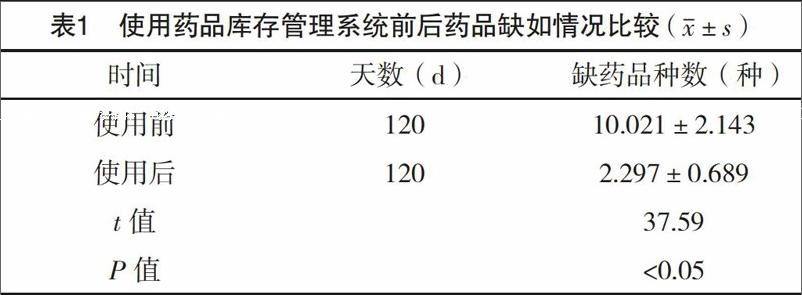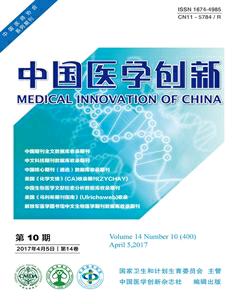计算门诊药房二级库药品库存上下限的方法分析
梁婉宁+赵育鹏+廖志斌



【摘要】 目的:分析計算门诊药房二级库药品库存上下限的方法,提高领药效率,减少药物长期积压,提高工作人员效率。方法:根据工作人员经验,参考合适的计算方法,确定药品最适库存天数及上下限库存天数。使用库存管理系统前后120 d的情况进行比较,比较的项目有药品缺如情况、药品平均库存天数、领药时间、日均领药品种数。结果:本院门诊药房药品的最适库存天数为9 d;本研究工作人员结合工作经验及其它有效信息,最终确定本院药品上下限库存天数如下:Ⅲ1=13,Ⅲ2=5,Ⅳ1=10,Ⅳ2=3;同时,使用药品库存管理系统前120 d平均每天缺药品种数为(10.021±2.143)种,而在使用药品库存管理系统后120 d平均每天缺药品种数为(2.297±0.689)种,明显少于旧模式(P<0.05)。使用药品库存管理系统前120 d平均库存天数为(37.31±7.921)d,而在使用药品库存管理系统后120 d平均库存天数为(9.12±3.812)d,两比较差异有统计学意义(P<0.05);使用药品库存管理系统前120 d,领药次数为1008次,平均每次领药时间为(6.11±0.04)h,而在使用药品库存管理系统后120 d内,经统计得领药次数为1021次,平均每次领药时间为(0.59±0.12)h,使用药品库存管理系统前领药时间明显高于使用后,比较差异有统计学意义(P<0.05);使用药品库存管理系统前120 d日均领药品种数为(338.47±113.36)种,而在使用药品库存管理系统后120 d日均领药品种数为(200.87±50.21)种,两者比较差异有统计学意义(P<0.05)。结论:新模式下的门诊药房二级库能够在现有工作模式的基础上,利用计算门诊药房二级库药品库存上下限的方法提高工作效率和准确率,有助于提高医院的整体管理水平。
【关键词】 门诊药房二级库; 药品库存; 上下界限
Analysis the Method of Calculating Lower Limit of Drug Stock in the Two Level Library of the Outpatient Pharmacy/LIANG Wan-ning,ZHAO Yu-peng,LIAO Zhi-bin.//Medical Innovation of China,2017,14(10):140-144
【Abstract】 Objective:To analyze and calculate the lower bound on the two level of drug stock in the outpatient pharmacy,improve the drug efficiency,reduce the long-term backlog, and improve the efficiency of the staff.Method:According to the experience of staff,referring to the appropriate calculation method to determine the optimal inventory days and the number of days on the upper and lower limits of inventory.120 days before and after the use of inventory management system were compared.The project of drug, drug of average stock days, get the medicine time, average daily number of drug varieties were compared.Result:Our hospital outpatient pharmacy drugs that the optimal inventory days for 9 days.This research staff combined with work experience,and other useful information,ultimately determine the lower limit on hospital drugs inventory days was as follows:Ⅲ1=13,Ⅲ2=5,Ⅳ1=10,Ⅳ2=3.At the same time,the use of the drug inventory management system lack of drug species on an average day for 120 days before were(10.021±2.143)species, and in the use of the drug inventory management system after 120 days on average a day short of drug species were(2.297±0.689)species,significantly less than the old model(P<0.05).120 days before the use of the drug inventory management system average inventory days for (37.31±7.921)d, and in the use of the drug inventory management system after 120 days on average inventory days for (9.12±3.812)d,the difference was statistically significant(P<0.05).120 days before the use of the drug inventory management system, to bring medicine for 1008 times,the average time each took medicine for (6.11±0.04)h, while in use within 120 days after drug inventory management system,the number of statistics to get medicine for 1021 times, the average time each took medicine for (0.59±0.12) h,use of the drug inventory management system brought the medicine before time was significantly higher than after use, the difference was statistically significant(P<0.05).120 days before the use of the drug inventory management system daily drug species were (338.47±113.36)species, and daily average of 120 days after the use of the drug inventory management system brought the drug species were (200.87±50.21)species,the difference was statistically significant(P<0.05).Conclusion:Under the new model of outpatient pharmacy two library can be based on the existing mode of work,improve work efficiency and accuracy,help to improve the overall management level of the hospital.
【Key words】 Two level library of outpatient pharmacy; Drug inventory; Upper and lower limits
First-authors address:Gaoyao Peoples Hospital of Zhaoqing,Zhaoqing 526040,China
doi:10.3969/j.issn.1674-4985.2017.10.039
二级库一般设立在药房与药库之间,保证临床能够及时安全的用药,目前医院药房医院卫生管理正处于向电子化建设的阶段[1-2]。传统的二级库领药流程一般在申请领药前先自行查询药房存药量并根据一周前的处方缺少客观性[3],容易造成不必要的药物堆积或者缺乏,而且工作时间长、工作量大[4],对人力、物力都会造成不必要的浪费。目前各医院正在尝试应用药品库存管理系统[5-6],药品库存管理系统是通过药品库存上下限值对临床用药进行管理[7-9]。本文就新旧模式进行了对比,为医药管理提供理论依据,具体情况如下。
1 方法
1.1 传统二级库领药流程 首先自查药房库存,然后以常规出库急诊药房的药品数量为依据计算申请量,并且按照手工录入药品申请单的方式申请领药,患者自行前往药库领药[10]。
1.2 新模式下二级库工作流程 (1)基本药物设置:进入门诊药房药品管理系统,点击“入库需求”,出现“基本药物设置对话框”,同意设置所有药品的库存上下限,系统自动计算库存上下限;(2)申请报表:点击“申请报表”,打开“请领表”对话框,执行“生成记录”—“生成现有库存”—“生成计划需求”,系统自动统计出所需申请领取的药品,以及需要领药的数量,并且可以显示当天所需申请领取药品的品种和数量清单;(3)“提交”申请:经工作人员核实确认后,将数据传到药库(一级库)[11]。
1.3 计算方法 (1)药品日均用量(Ⅰ)=前30 d使用某种药品的消耗量/30;(2)药品最高日用量(Ⅱ)=每个月前30 d内某种药品用药量最大的一次消耗量;(3)库存上限天数(Ⅲ):库存上限量即为药品刚被领入库的库存量,按照药品日均用量使用下,库存上限量可使用的天数记为Ⅲ1,按照药品最高日用量的使用下,库存上限量可使用的天数记为Ⅲ2;(4)库存下限天数(Ⅳ):以药品日均用量使用下,库存下限量可使用的天数记为Ⅳ1,按照药品最高日用量的使用下,库存下限量可使用的天数记为Ⅳ2;(5)药品用量差异指数(Ⅴ)=某药品最高日用量/日均用量(Ⅱ/Ⅰ);(6)最适库存天数=所有药品平均库存天数的算数平均值[12]。
1.4 统计学处理 使用SPSS 18.0统计软件进行分析,计量资料以(x±s)表示,比较采用t检验,以P<0.05为差异有统计学意义。
2 结果
2.1 药品最适库存天数及上下限库存天数的确定 (1)药品最适库存天数:经计算可知,本院门诊药房的最适库存天数为9 d。(2)药品上下限库存天数:计算得药品用量差异指数(V),若V≥5,用药品最高日用量(Ⅱ)来计算该要的库存上、下限量;若V<5,用药品日均用量(Ⅰ)计算库存上、下限量。本次研究中,工作人员结合工作经验及其它有效信息,最终确定本院药品上下限库存天数如下:Ⅲ1=13,Ⅲ2=5,Ⅳ1=10,Ⅳ2=3。
2.2 使用药品库存管理系统前后药品缺如情况比较 使用药品库存管理系统后120 d平均每天缺药品种数为明显少于旧模式,比较差异均有统计学意义(P<0.05),见表1。
2.3 使用药品库存管理系统前后药品平均库存天数比较 使用药品库存管理系统前后平均库存比较差异有统计学意义(P<0.05),见表2。
2.4 使用药品库存管理系统前后领药时间比较 使用药品库存管理系统前领药时间明显高于使用后,比较差异有统计学意义(P<0.05),见表3。
2.5 使用药品库存管理系统前后日均领药品种数比较 使用药品库存管理系统后日均领药品种数明显小于使用前,两者比较差有统计学意义(P<0.05),见表4。
3 讨论
门诊药房药物流量较大[13],且药物种类较多[14],因此需要在药房与药库之间设立二级库,从而对医药信息进行有效的管理。传统二级库模式需要工作人员每天对库存进行检查并且计算上周药品的消耗,并且结合工作经验,判断领药数量,当患者需要领药时,还需填写申请领取单,从而造成了对人力资源的浪费,降低了工作人员的办事效率,而且患者取药时间较长。另外传统药物统计方法不具有客观性,容易计算出不准确的信息[10-15],从而造成药物积压现象,造成不必要的浪费,或者导致药物缺乏,造成患者不能及时用药。因此,近年来,各医院致力于建设新系统[16-18],使药物管理规范化[13,19],使领药、备药模式具有客观性、合理性。
本文就药品库存管理系统的分析方法—门诊药房二级库药品库存上下限进行了探讨研究,结果显示使用药品库存管理系统前120 d平均每天缺药品种数明显多于使用药品库存管理系统后120 d平均每天缺药品种数为(P<0.05),提示計算门诊药房二级库药品库存上下限的方法能够明显改善药品缺如情况,有助于患者及时用药。使用药品库存管理系统前120 d平均库存天数为(37.31±7.921)d,明显高于使用药品库存管理系统后120 d平均库存天数为(9.12±3.812)d(P<0.05),提示计算门诊药房二级库药品库存上下限的方法能够正确指导领药、备药,从而避免药物过度堆积、浪费。此外,经计算可知本院门诊药房的最适库存天数为9 d,使用药品库存管理系统后平均库存天数接近最适库存天数,而传统模式却远远高于最适值,说明使用计算门诊药房二级库药品库存上下限的方法对药物管理更理想化,更加有效,有利于提高医院工作人员工作的正确性[20]。同时,使用药品库存管理系统后日均领药品种数明显减少(P<0.05),方便统计,这也在一定程度上减少了工作人员的工作量,避免不必要的人力资源浪费。对患者来说,使用药品库存管理系统前领药时间明显高于使用后,比较差异有统计学意义(P<0.05),从而保证患者及时得到适当的药物治疗,也有利于节省患者时间,提高患者满意度[21],进而有助于医患关系的和谐发展。
常规的库存周转率和库存资金占用率等指标在反映库存周转情况方面存在局限性,因此需要对常规库存周转分析方法加以改进,使管理人员能够了解整个时间段内任意时刻的库存周转情况。在药品库存周转分析中引入物资流动曲线,既可以准确地计算任意时间段内药品的平均库存和库存周转率,还能够提供库存流通的动态信息,从而实现药品库存的动态分析。在药库的日常工作中,很多药品的流通具有较大的波动性,原因包括季节、节假日、流行病等因素的影响,以及同类品种竞争、生产厂家的宣传推广等多种随机情况。动态库存分析方法使药库管理人员能够直观地了解药品的历史库存状态,并通过综合分析各种影响因素,最终确定合适的采购计划,合理调配发往各药房的出库数量。这样既可避免库存过多导致积压甚至因药品过期而退货,又可防止库存过少导致断货或者因频繁采购而增加工作量。此外,国内已经尝试将多种预测方法和数学模型应用于医院药品的消耗预测和采购计划,其结果验证方式主要是将药品在特定周期内的实际消耗量和预测消耗量进行对比。动态库存分析方法可以为药品库存预测模型提供丰富的验证参数和模式,包括平均库存、周转时间、流通速度、周期出入庫量和库存周转量等指标,为药库管理人员提供更多样、有效的决策支持手段。
有学者研究认为,实施二级药库管理后,药库的药品库存量大幅减少,节约药库的占地面积,医院可以腾出更大的医疗空间向社会提供服务。药库、药房库存管理人员变一周多次领药为一次,提高了药品采购效率和管理水平,减少了人力资源投入,提高了工作效率。库存结构优化,加快资金周转率,减轻了医院运营成本。实施二级药库管理后,除特殊控制药品外,其余常规药品直接配送到药房,降低药库的药品库存,优化库存结构,有效地控制药品进、出、购、销、存、用环节,药品库存金额明显减少,为医院减少大量的运营成本,增加了流动资金的周转速度,创造了很大的经济效益。医院药库实行二级药库管理后,对医药公司的备货和及时配送提出了更高要求,作为二级城市的宁波各大医药公司为增强竞争力,通常乐意做好配送服务,但供应商的备货情况和配送能力也会受各种因素的影响,不可避免地会出现缺货现象。所以在药剂科内各药房之间建立联动机制,在供应商暂时不能及时供应的情况下,可以先主动在科内各药房之间调拨使用,使缺药问题得到妥善解决,保证临床用药供应及时。
门诊药房药品种类繁多,每周一次采购配送并要求控制库存量,对药房的药品质量管理带来更大挑战,门诊药房直接面对门诊患者必须保证药品质量安全有效,药房要严格执行“先进先出、近期先出”的原则,定期药品养护,保证合格的储存条件,落实有效期管理制度,避免一种药品多批次混放,减少药品损耗。医院药库实行二级药库管理后,可以建立区域性的医院药品供应模式,让医院的药品采购、存储、配送走向社会化和专业化。在此模式下,医院慎重选择实力强、可靠的供应商作为长期合作伙伴,签订合同。供应商通过和医院建立的电子商务平台,获得医院的药品使用和需求信息,及时进行少量多次配送。在这种模式下,医院将药品的采购、存储和管理从医院的功能中剥离出来,交由更加专一的药品配送中心负责,切断药品与医务人员之间的直接联系,这样就从根源上阻断不正之风的滋生,部分杜绝医生开药的过程中吃回扣的现象。医院甩掉了药品库存,轻装上阵,减少药库对宝贵的场地占用,医院可以腾出更大的医疗空间向社会提供服务,为下一步医药分家的改革奠定了良好的基础。
当然,使用新系统管理时也应注意以下几个方面的问题:首先,门诊药房的二级库药品库存管理系统的药品库存的上下限也是固定不变的,如果遇到随季节性变化的药品也需要随季节的变化将其设置为最高、最低库存[22]。而且,在本系统的应用过程中,也需要不断的验证其设置的合理性,当其出现与实际情况不符合的情况时[23-24],如季节性流感,感冒药需求量远远超过平时,应根据实际情况来对系统进行相应的调整[25-27]。其次,应及时对药房二级库内的药品库存数量以及品种记录在案,尤其对一些常用药的库存量进行每天统计甚至做出周或者月的出库曲线,作为制定入库的依据,也有助于提前设定并修改存限量以及报警上下限[28-31]。
综上所述,新模式下的门诊药房二级库能够在现有工作模式的基础上,利用计算门诊药房二级库药品库存上下限的方法对药物进行管理,能够提高工作效率和准确率,有助于提高医院的整体管理水平。
参考文献
[1]朱晔,唐婕.品管圈活动对门诊药房药品库存周转率的效果评价[J].抗感染药学,2014,11(4):341-344.
[2]杨昕婧,于西全,陈大鹏,等.我院门诊药房二级库药品库存上下限计算方法的探讨[J].中国药房,2015,13(12):1863-1865.
[3]林铃,杨昕婧,于西全.医院二级库药品请领程序的使用分析[J].中国医院药学杂志,2016,12(7):1034-1036.
[4] Viswanathan M,Kahwati L C,Golin C E,et al.Medication therapy management interventions in outpatient settings: a systematic review and meta-analysis[J].Jama Intern Med,2015,175(1):76-87.
[5]钟曙.医院信息系统药品管理子系统的设计与实现[D].济南:山东大学,2009.
[6]颜耀东,王楠,刘东麟,等.医院药品库存管理系统的构建与效果评价[J].中国医院药学杂志,2013,7(11):578-580.
[7]王衍洪.我院药品管理系统的构建和应用[J].中国药房,2007,13(9):993-996.
[8] Trap B, Kikule K, Vialle-Valentin C,et al.First regulatory inspections measuring adherence to Good Pharmacy Practices in the public sector in Uganda: a cross-sectional comparison of performance between supervised and unsupervised facilities[J].
J Pharm Policy Pract,2016,9(12):18.
[9]王麗姿,马海波,姜红,等.医院门诊药房库存管理的探讨[J].中国药房,2007,18(19):1471-1472.
[10]常超.河南封丘县中医院药品库存管理研究[D].天津:天津商业大学,2013.
[11]邬蓉,徐德铎,李志文,等.门诊药房现代化药品物流与调剂体系的建设实践[J].中国药房,2016,27(22):3095-3098.
[12]李津.医院门诊药房拣选系统建模与优化设计[D].济南:山东大学,2010.
[13]蔡玉娟.医院门诊药房二级仓库管理与维护的探讨[J].中国医药指南,2012,10(17):378-380.
[14]杨松,杨东升,郑晓元,等.药品监管能力理论研究与模型框架(英文)[J].Journal of Chinese Pharmaceutical Sciences,2015,(4):257-262.
[15] Hamilton W L,Doyle C,Halliwell-Ewen M,et al.Public health interventions to protect against falsified medicines: a systematic review of international, national and local policies[J].Health Policy Plan,2016,31(10):1446-1448.
[16] Murphy A P,Bentur H,Dolan C,et al.Outpatient anti-epileptic drug prescribing errors in a Childrens Hospital:An audit and literature review[J].Seizure:the journal of the British Epilepsy Association,2014,23(9):786-791.
[17] Hall D L,Pater K S.Implementation of a Medication Therapy Management Program in a Hospital-Based Outpatient Pharmacy[J].Hospital pharmacy: A peer-reviewed journal for hospital and organized health care systems pharmacists,2011,46(7):512-518.
[18] Lankheet N A G,Knapen L M,Schellens J H M,et al.Plasma concentrations of tyrosine kinase inhibitors imatinib, erlotinib, and sunitinib in routine clinical outpatient cancer care[J].Therapeutic Drug Monitoring,2014,36(3):326-334.
[19] Wu M,Sin A,Nishioka F,et al.Non-drug costs associated with outpatient infliximab administration in pediatric inflammatory bowel disease[J].Inflammatory Bowel Diseases,2013,19(7):1514-1517.
[20] Desai V C A,Cavanaugh T M,Kelton C M L,et al.Trends in the Utilization of, Spending on, and Prices for Outpatient Antifungal Agents in US Medicaid Programs:1991-2009[J].Clinical Therapeutics,2012,34(10):2118-2131.
[21] Chew C,Chiang J,Yeoh T T.Impact of outpatient interventions made at an ambulatory cancer centre oncology pharmacy in Singapore[J].J Oncol Pharm Pract,2015,21(2):93-101.
[22] Ponto T,Ismail N I,Abdul Majeed A B,et al.A prospective study on the pattern of medication use for schizophrenia in the outpatient pharmacy department,Hospital Tengku Ampuan Rahimah,Selangor,Malaysia.[J].Methods and Findings in Experimental and Clinical Pharmacology,2010,32(6):427-432.
[23] Phillips B B,Williams K C.Implementation of a pharmacy residency in a Veterans Affairs community-based outpatient clinic[J].American Journal of Health System Pharmacy,2012,69(10):880-884.
[24] Jager N G L,Rosing H,Schellens J H M,et al.Tamoxifen dose and serum concentrations of tamoxifen and six of its metabolites in routine clinical outpatient care[J].Breast Cancer Research and Treatment,2014,143(3):477-483.
[25] Ghaswalla P K,Harpe S E,Tassone D,et al.Warfarin-antibiotic interactions in older adults of an outpatient anticoagulation clinic[J].The American Journal of Geriatric Pharmacotherapy,2012,10(6):352-360.
[26] Kuo G M,Touchette D R,Marinac J S,et al.Drug errors and related interventions reported by united states clinical pharmacists: The american college of clinical pharmacy practice-based research network medication error detection, amelioration and prevention study[J].Pharmacotherapy,2013,33(3):253-265.
[27] Desai V C A,Heaton P C,Kelton C M L,et al.Impact of the Food and Drug Administrations antipsychotic black box warning on psychotropic drug prescribing in elderly patients with dementia in outpatient and office-based settings[J].Alzheimers Demet,2012,8(5):453-457.
[28] Shah S,Dowell J,Greene S,et al.Evaluation of clinical pharmacy services in a hematology/oncology outpatient setting[J].The Annals of Pharmacotherapy,2006,40(9):1527-1533.
[29] Lee Y Y,Kuo L N,Chiang Y C,et al.Pharmacist-conducted medication reconciliation at hospital admission using information technology in Taiwan[J].International Journal of Medical Informatics,2013,82(6):522-527.
[30] Bao L,Wang Y,Shang T,et al.A novel clinical pharmacy management system in improving the rational drug use in department of general surgery[J].Indian Journal of Pharmaceutical Sciences,2013,75(1):11-15.
[31] Yeh M L,Chang Y J,Yeh S J,et al.Potential drug-drug interactions in pediatric outpatient prescriptions for newborns and infants[J].Computer Methods and Programs in Biomedicine,2014,113(1):15.

